Global Account Search
- Browser
- iPad
Global Account Search is a tool to search for and add accounts currently outside a user’s territory, making it easier to interact with these accounts. Global Account Search also helps reduce the creation of unnecessary accounts, as users can first check if an account already exists outside of their territory before creating a new account.
For example, Sarah Jones visits Dr. Ackerman, who introduces her to Dr. Bob Adams, a doctor who has recently moved into Sarah’s territory. Sarah searches for Bob Adams in CRM and sees that her org already has an account for him, currently outside her territory. Sarah is able to add Dr. Adams to her territory, enabling her to schedule calls with him.
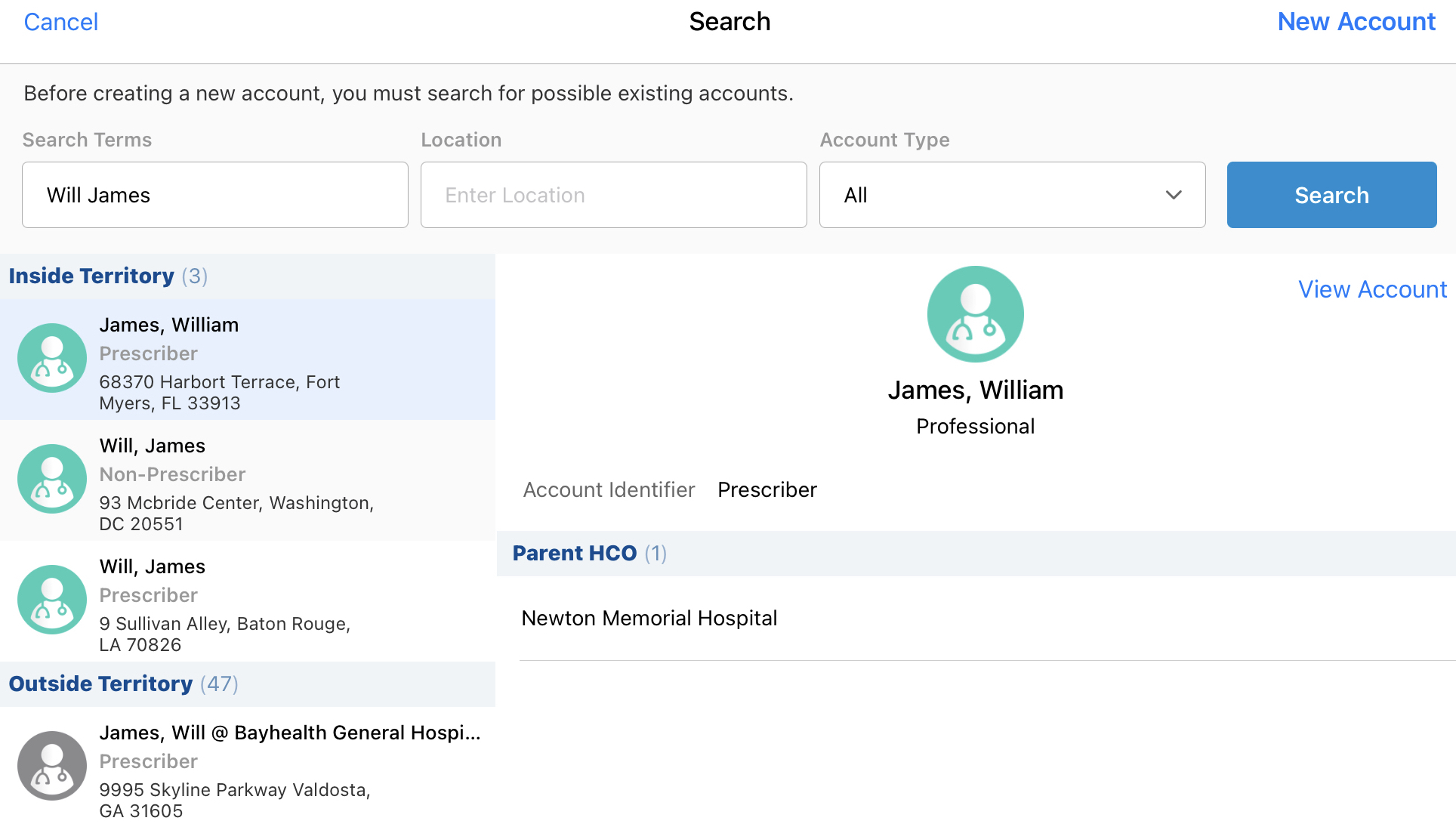
Configuring Global Account Search
To enable this feature:
-
Grant admins the following permissions:
Object
OLS
Record Type
Fields
FLS
Implicit_Filter_vod
CRUD
n/a
- Location_vod
- Applies_To_vod
- Inclusion_vod
Edit
Implicit_Filter_Condition_vod
CRUD
n/a
- Object_Name_vod
- Field_Name_vod
- Criteria_vod
- Implicit_Filter_vod
Edit
- Grant all users access to the VeevaGlobalAccountSearchController Apex class.
-
Create and assign users and admins to the following Lightning Component tab:
- Global Account Search
- Tab Name – Global_Account_Search_vod
- Content – globalAccountSearch
-
Create and assign admins to the following Lightning Component tab:
- Global Account Search Configuration
- Tab Name – Global_Account_Search_Configuration_vod
- Content – globalAccountSearchAdminPage
-
Populate the Enable_Global_Account_Search_vod Global Account Search Setting with a value of 1.
This step is only required when configuring this feature for the iPad platform.
-
Activate the appropriate VMOCs for the Global_Account_Search_Settings_vod object.
Hiding the New Account Button in Global Account Search
Some organizations use a custom New Accounts page for creating accounts. Admins can hide the default New Account button by enabling the Hide New Account Button setting in Global Account Search Settings.
Considerations
- The Hide New Account Button setting overrides other configurations that impact whether the New Account Button displays on Global Account Search
- The Hide New Account Button setting should be used in conjunction with the My_Accounts_Redirect_vod setting in Global Account Search Settings, which displays the Global Account Search page when users attempt to create a new account in My Accounts
Configuration
To configure this feature:
- Ensure Configuring Accounts and Configuring Global Account Search are complete.
- Navigate to Setup > Custom Code > Custom Settings > Global Account Search Settings.
- Select the Hide New Account Button check box.
When this setting is enabled, the New Account Button is not available on the Global Account Search page.

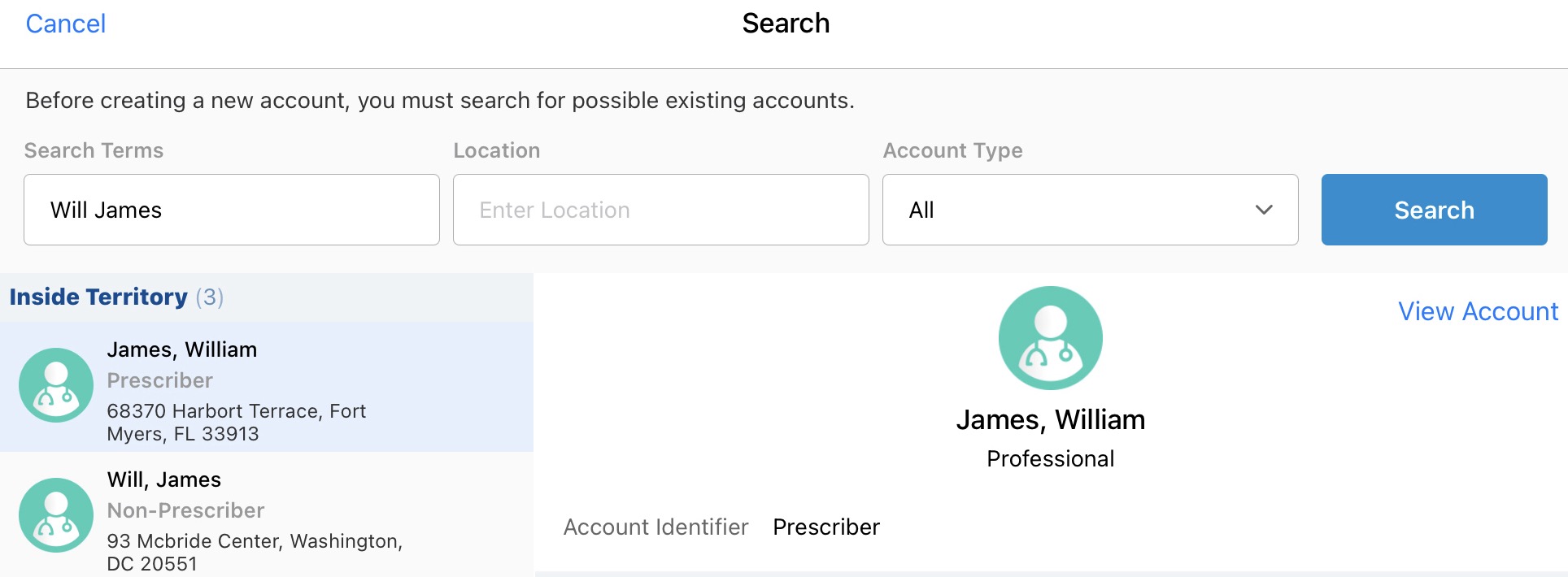
Custom Filters for Global Account Search
Browser (Lightning) users can apply custom filters to find accounts more easily when using Global Account Search. Admins can set up custom filters for any field on the Account or Address object.
For example, Verteo Biopharma is promoting a new product for managing diabetes. Sarah Jones wants to compile a list of all accounts in her organization with a specialty in that area of treatment. From the Global Account Search tab, she selects Diabetes from the Specialty filter set up by the org’s admin. This narrows her results to only display accounts specializing in diabetes.
Considerations
The following field types are not supported:
- Long text
- Text Area
- URL
- Date
- Date/Time
- Geolocation
- Phone
Defining Available Fields for Custom Filters
Standard or custom fields on the Account and Address_vod objects can be defined as fields available in custom filters.
To prevent conflicts, any fields defined as available for inclusive Implicit Filters should not be defined for Custom Filters for the same profile.
To define the fields available for filtering:
- Navigate to Global Account Search settings.
- Populate the GAS_User_Filters_vod setting with the appropriate Veeva Message. The default message is GAS_USER_FILTERS;;Global Account Search.
-
Populate the Veeva Message defined in the setting with a semicolon-delimited list of the fields to make available to custom filters. Use the following format:
ObjectAPIName.Field1APIName; ObjectAPIName.Field2APIName;For example, Account.Specialty_1_vod__c;Account.Credentials_vod__c;
Implicit Filters for Global Account Search
Implicit filters are admin-defined filters based on defined fields that include or exclude sets of accounts from Global Account Search results, reducing the number of potentially unnecessary results and granting greater control over the results displaying to users.
Defining Available Fields for Implicit Filters
Standard or custom fields on the Account and Address_vod objects can be defined as fields available in implicit filters. The following field types are not supported:
- Long text
- Text Area
- URL
- Date
- Date/Time
- Geolocation
- Phone
To define the fields available for filtering:
- Navigate to Global Account Search settings.
- Populate the GAS_Implicit_Filters_vod setting with the appropriate Veeva Message. The default message is GAS_IMPLICIT_FILTERS;;Global Account Search.
-
Populate the Veeva Message defined in the setting with a semicolon-delimited list of the fields to make available to implicit filters. Use the following format:
ObjectAPIName.Field1APIName; ObjectAPIName.Field2APIName;
For example, Account.RecordTypeId;Address_vod__c.State_vod__c;Account.Specialty_vod__c
Creating Implicit Filters
To create an implicit filter:
- Navigate to the Global Account Search Configuration tab.
- Select New in the Implicit Filters section.
-
Populate the following fields:
-
Location_vod – Defines the scope of the implicit filter. If multiple implicit filters apply to a user, the implicit filter most specific to the user is applied to their search.
Select one of the following options:
- Organization-Wide Default
- Profile
- Territory – Applies if the user is assigned to either a territory matching an implicit filter or any territory below a matching territory in the hierarchy
- Applies_To_vod – Defines which specific group the implicit filter applies to. The value of this field depends on the selection of the Location_vod field:
- If Organization-Wide Default was selected, this field is disabled
- If Profile was selected, this serves as a single-select picklist with all profiles in the org
- If Territory was selected, this field serves as a single-select picklist with all territories in the org
- Inclusion_vod – Defines whether the filter is an inclusive or an exclusive filter:
- If this field is selected, the filter is inclusive and accounts must meet the implicit filter criteria in order for them to display as results. This is the default option.
- If this field is not selected, the filter is exclusive and the accounts cannot meet the implicit filter criteria in order for them to display as results
- Record Type – A multi-select picklist that defines the account record types either included or excluded based on the filter
-
-
Populate all appropriate fields in the Filter section based on the defined available fields.
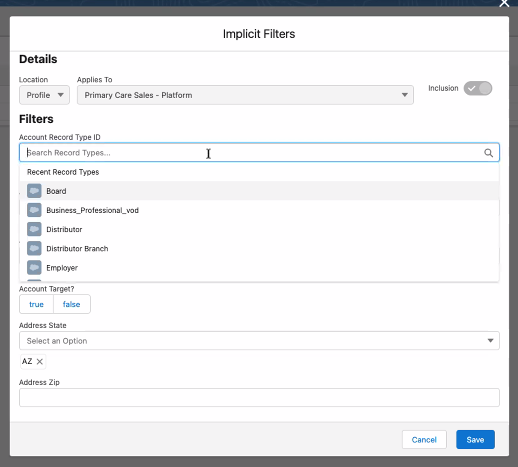
- Select Save.
For example, the admin creates the following Implicit_Filter_vod record with the following values:
- Location_vod – Profile
- Applies_To_vod – Primary Care Sales Platform
- Inclusion_vod – Selected
- Record Type – Professional_vod, KOL_vod, Hospital_vod
- Address State – AZ
Sarah Jones is a Primary Care Sales - Platform user who searches for “Bob” in Global Account Search. Bob Adams is an account with a record type of Professional_vod located in Arizona, so he displays as a result. Bob Richards is an account with a record type of Practice_vod, so he does not display as a result.
Using Global Account Search in the Browser
Users can access Global Account Search via the dedicated Global Account Search tab.
Before selecting Search, users can define the following search parameters:
- Account Type – Filters results based on the type of account:
- HCP – Filters results to only Person Accounts
- HCO – Filters results to only Business Accounts
- All – Does not filter results
- Name – Creates a fuzzy match search against text fields on the Account object
- Location – Searches for matches against text fields on the Address_vod object
The search may return up to 100 results. Users can select the Filter button to further refine the list of results by specialty and credentials.
Results display as a table with the information about each result’s record type, name, specialty, and address.
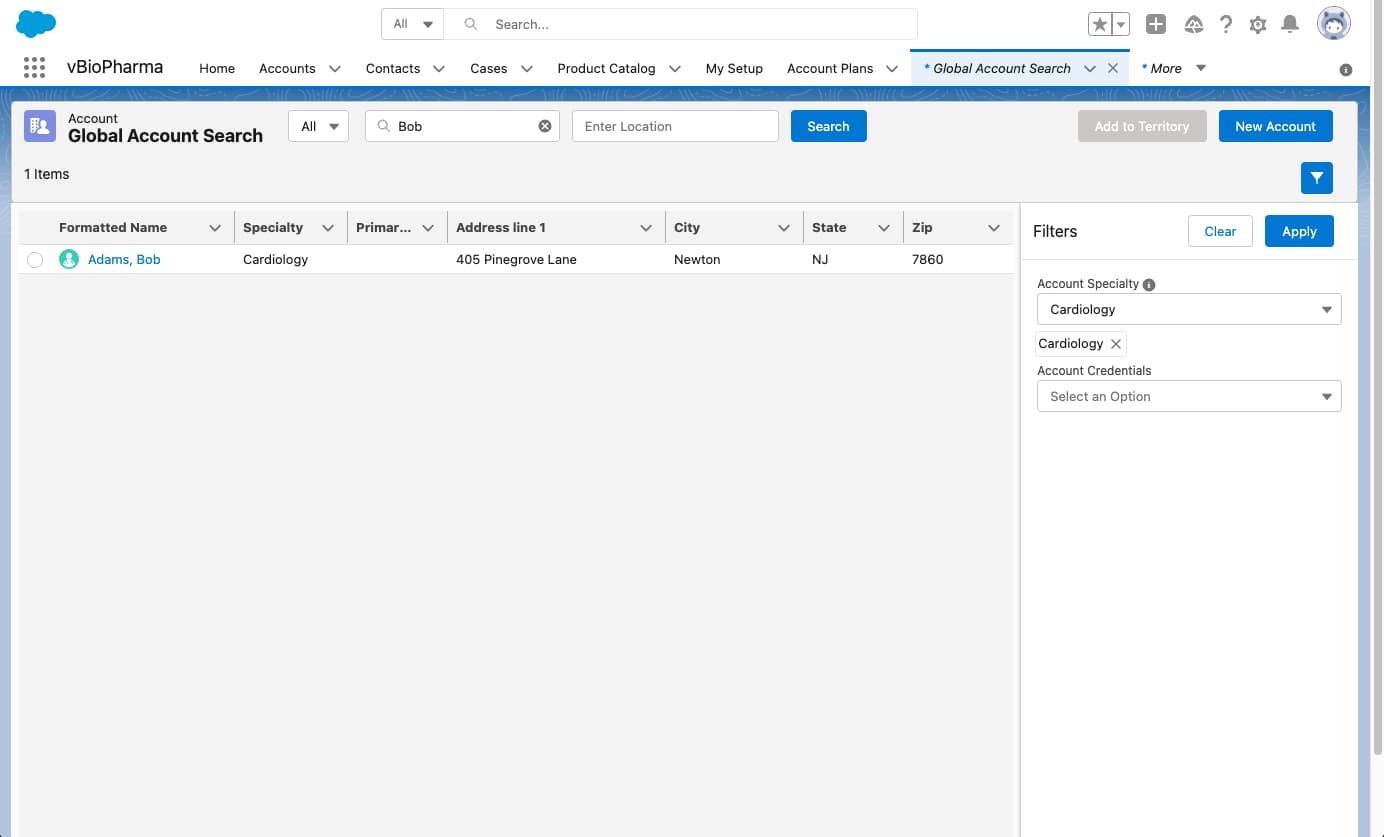
Each of these columns can be sorted for further accuracy.
If the desired account does not display in results, users can select the New Account button to launch the New Account Wizard. If the user’s organization is configured for Decoupled DCRs, the New Account Button displays even if the user does not have OLS on the Account object, and launches a version of the wizard that creates a DCR for the new account.
Adding an Account From Outside a User’s Territory
Users can also add accounts from outside of their territory from the Global Account Search page:
- Search for the appropriate account.
- Select the check box in the results table for the appropriate out of territory account.
- Select Add to Territory.
-
Select the appropriate parent accounts to also add to the territory. This step is optional and only displays if the account is a child account.

-
Select the appropriate territory to assign the account. This step only applies to users assigned to multiple territories.

The Add to Territory process leverages ATL functionality for territory assignment.
Using Global Account Search on the iPad
Users can access Global Account Search by selecting the + button on the My Accounts tab. When Global Account Search is enabled, iPad users must first search for an existing account before they can create a new account.

Before selecting Search, users can define the following search parameters:
- Account Type – Filters results based on the type of account:
- HCP – Filters results to only Person Accounts
- HCO – Filters results to only Business Accounts
- All – Does not filter results
- Name – Creates a fuzzy match search against text fields on the Account object
- Location – Searches for matches against text fields on the Address_vod object
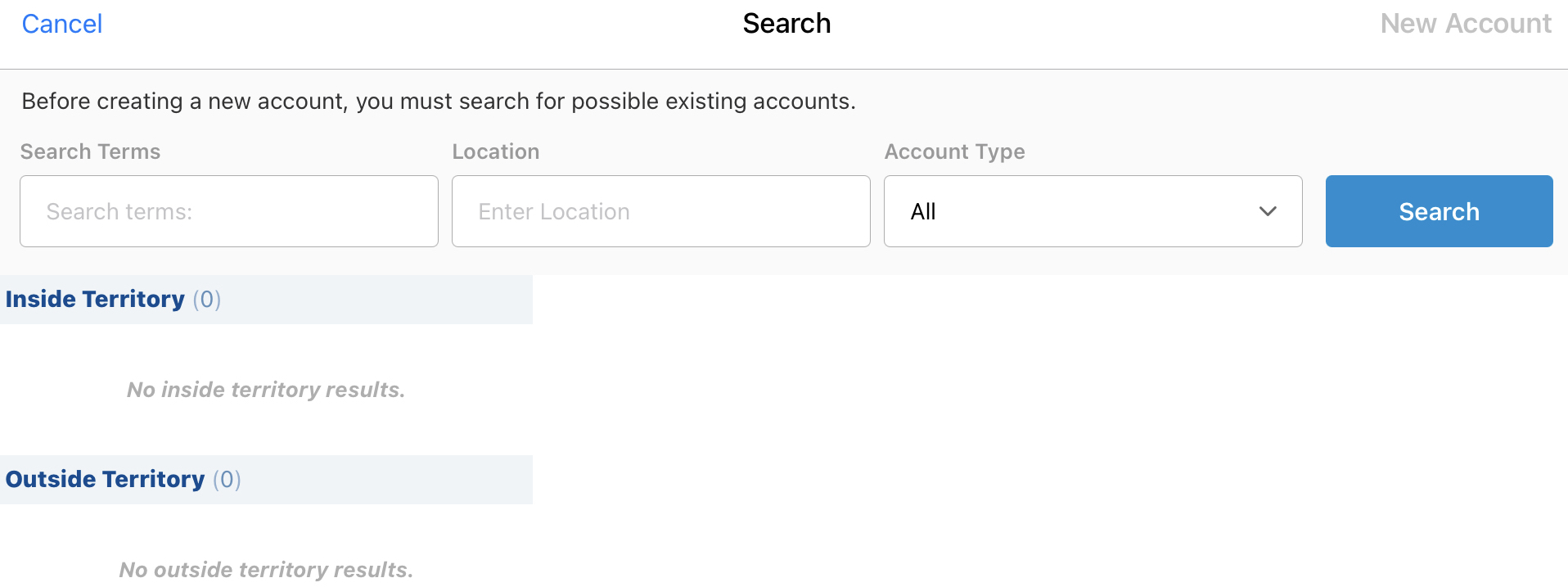
The search may return up to 70 results on the iPad, depending on whether the device is connected to the internet. The results are divided into two categories:
- Inside Territory – The account is currently assigned to the same territory as the user
- Outside Territory – The account is currently not assigned to the same territory as the user
If the user is using an iPad not connected to the internet at the time the search occurs, results still display, but are limited to only accounts currently synced to the device. Up to 20 synced accounts can return based on the search criteria when only searching synced accounts. If the iPad is connected to the internet, up to 50 additional in-territory accounts may be returned.
Users can preview results by selecting the account in the results panel to display the account’s name, identifier, and any parent accounts.

Users can view the previewed account by selecting the View Account button.
If the desired account does not display in results, users can select the New Account button to launch the New Account Wizard. If the user’s organization is configured for Decoupled DCRs, the New Account Button displays even if the user does not have OLS on the Account object, and launches a version of the wizard that creates a DCR for the new account.
Adding an Account From Outside a User’s Territory on the iPad
Users can also add accounts from outside of their territory from the Global Account Search page:
- Search for the appropriate account.
- Select the appropriate result to preview the out of territory account.
- Select Add Account.
- Select the appropriate parent accounts to also add to the territory. This step is optional and only displays if the account is a child account.
- Select the appropriate territory to assign the account or accounts. This step only applies to users assigned to multiple territories.
The Add to Territory process leverages ATL functionality for territory assignment.
When users of CRM on iPad add an account to their territory from Global Account Search, a Mini Sync retrieves the account-related records, including records needed to comply with sampling rules. This helps users keep their mobile devices up-to-date and reduces the need to perform manual refreshes or Incremental Syncs after taking certain actions like adding a new account. The following objects are included in the Mini Sync:
- Affiliation_vod
- TSF_vod
- Sample_Limit_vod
- Sample_Limit_Transaction_vod
- Account_Authorization_vod
Adding Accounts from the Hierarchy on the iPad
Users with Account Hierarchies enabled can also add out of territory accounts directly from an account’s hierarchy.
- Navigate to the View Hierarchy tab on the appropriate account. Accounts in the hierarchy outside of the user’s territory display with a gray background.
-
Select the + button for the appropriate account.
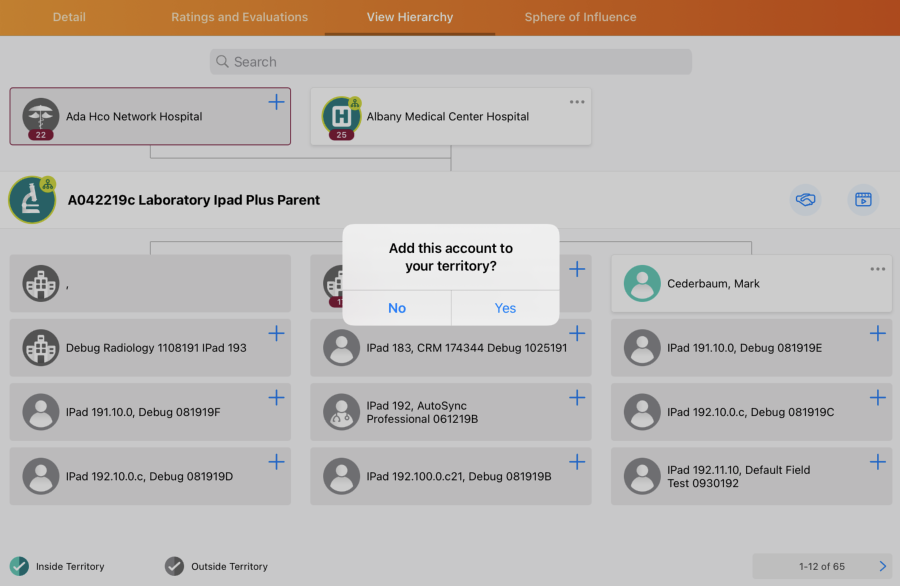
- Select Yes.
This functionality is mutually exclusive with Adding Parent HCOs to Territories in Network.
Considerations
If Network Account Search and Global Account Search are both enabled for a user's profile, Network Account Search is used instead of Global Account Search



